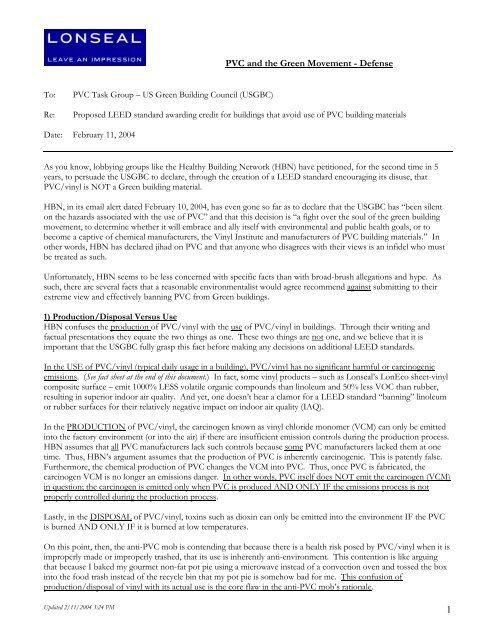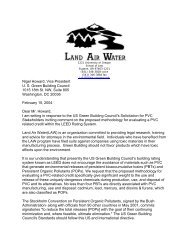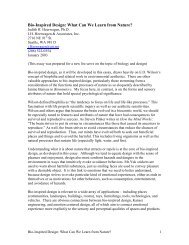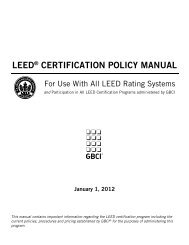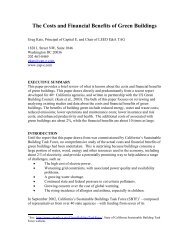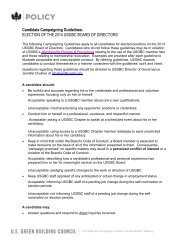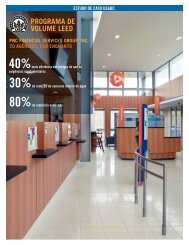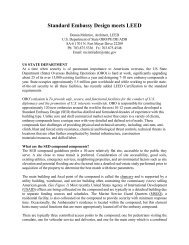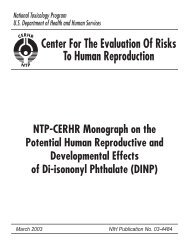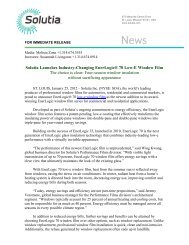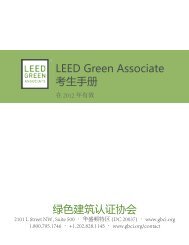PVC and the Green Movement - US Green Building Council
PVC and the Green Movement - US Green Building Council
PVC and the Green Movement - US Green Building Council
You also want an ePaper? Increase the reach of your titles
YUMPU automatically turns print PDFs into web optimized ePapers that Google loves.
<strong>PVC</strong> <strong>and</strong> <strong>the</strong> <strong>Green</strong> <strong>Movement</strong> - DefenseTo:Re:<strong>PVC</strong> Task Group – <strong>US</strong> <strong>Green</strong> <strong>Building</strong> <strong>Council</strong> (<strong>US</strong>GBC)Proposed LEED st<strong>and</strong>ard awarding credit for buildings that avoid use of <strong>PVC</strong> building materialsDate: February 11, 2004As you know, lobbying groups like <strong>the</strong> Healthy <strong>Building</strong> Network (HBN) have petitioned, for <strong>the</strong> second time in 5years, to persuade <strong>the</strong> <strong>US</strong>GBC to declare, through <strong>the</strong> creation of a LEED st<strong>and</strong>ard encouraging its disuse, that<strong>PVC</strong>/vinyl is NOT a <strong>Green</strong> building material.HBN, in its email alert dated February 10, 2004, has even gone so far as to declare that <strong>the</strong> <strong>US</strong>GBC has “been silenton <strong>the</strong> hazards associated with <strong>the</strong> use of <strong>PVC</strong>” <strong>and</strong> that this decision is “a fight over <strong>the</strong> soul of <strong>the</strong> green buildingmovement, to determine whe<strong>the</strong>r it will embrace <strong>and</strong> ally itself with environmental <strong>and</strong> public health goals, or tobecome a captive of chemical manufacturers, <strong>the</strong> Vinyl Institute <strong>and</strong> manufacturers of <strong>PVC</strong> building materials.” Ino<strong>the</strong>r words, HBN has declared jihad on <strong>PVC</strong> <strong>and</strong> that anyone who disagrees with <strong>the</strong>ir views is an infidel who mustbe treated as such.Unfortunately, HBN seems to be less concerned with specific facts than with broad-brush allegations <strong>and</strong> hype. Assuch, <strong>the</strong>re are several facts that a reasonable environmentalist would agree recommend against submitting to <strong>the</strong>irextreme view <strong>and</strong> effectively banning <strong>PVC</strong> from <strong>Green</strong> buildings.1) Production/Disposal Versus UseHBN confuses <strong>the</strong> production of <strong>PVC</strong>/vinyl with <strong>the</strong> use of <strong>PVC</strong>/vinyl in buildings. Through <strong>the</strong>ir writing <strong>and</strong>factual presentations <strong>the</strong>y equate <strong>the</strong> two things as one. These two things are not one, <strong>and</strong> we believe that it isimportant that <strong>the</strong> <strong>US</strong>GBC fully grasp this fact before making any decisions on additional LEED st<strong>and</strong>ards.In <strong>the</strong> <strong>US</strong>E of <strong>PVC</strong>/vinyl (typical daily usage in a building), <strong>PVC</strong>/vinyl has no significant harmful or carcinogenicemissions. (See fact sheet at <strong>the</strong> end of this document.) In fact, some vinyl products – such as Lonseal’s LonEco sheet-vinylcomposite surface – emit 1000% LESS volatile organic compounds than linoleum <strong>and</strong> 50% less VOC than rubber,resulting in superior indoor air quality. And yet, one doesn’t hear a clamor for a LEED st<strong>and</strong>ard “banning” linoleumor rubber surfaces for <strong>the</strong>ir relatively negative impact on indoor air quality (IAQ).In <strong>the</strong> PRODUCTION of <strong>PVC</strong>/vinyl, <strong>the</strong> carcinogen known as vinyl chloride monomer (VCM) can only be emittedinto <strong>the</strong> factory environment (or into <strong>the</strong> air) if <strong>the</strong>re are insufficient emission controls during <strong>the</strong> production process.HBN assumes that all <strong>PVC</strong> manufacturers lack such controls because some <strong>PVC</strong> manufacturers lacked <strong>the</strong>m at onetime. Thus, HBN’s argument assumes that <strong>the</strong> production of <strong>PVC</strong> is inherently carcinogenic. This is patently false.Fur<strong>the</strong>rmore, <strong>the</strong> chemical production of <strong>PVC</strong> changes <strong>the</strong> VCM into <strong>PVC</strong>. Thus, once <strong>PVC</strong> is fabricated, <strong>the</strong>carcinogen VCM is no longer an emissions danger. In o<strong>the</strong>r words, <strong>PVC</strong> itself does NOT emit <strong>the</strong> carcinogen (VCM)in question; <strong>the</strong> carcinogen is emitted only when <strong>PVC</strong> is produced AND ONLY IF <strong>the</strong> emissions process is notproperly controlled during <strong>the</strong> production process.Lastly, in <strong>the</strong> DISPOSAL of <strong>PVC</strong>/vinyl, toxins such as dioxin can only be emitted into <strong>the</strong> environment IF <strong>the</strong> <strong>PVC</strong>is burned AND ONLY IF it is burned at low temperatures.On this point, <strong>the</strong>n, <strong>the</strong> anti-<strong>PVC</strong> mob is contending that because <strong>the</strong>re is a health risk posed by <strong>PVC</strong>/vinyl when it isimproperly made or improperly trashed, that its use is inherently anti-environment. This contention is like arguingthat because I baked my gourmet non-fat pot pie using a microwave instead of a convection oven <strong>and</strong> tossed <strong>the</strong> boxinto <strong>the</strong> food trash instead of <strong>the</strong> recycle bin that my pot pie is somehow bad for me. This confusion ofproduction/disposal of vinyl with its actual use is <strong>the</strong> core flaw in <strong>the</strong> anti-<strong>PVC</strong> mob’s rationale.Updated 2/11/2004 3:24 PM1
<strong>PVC</strong> <strong>and</strong> <strong>the</strong> <strong>Green</strong> <strong>Movement</strong> - Defense2) Vinyl’s Environmental VirtuesThe general underst<strong>and</strong>ing of <strong>the</strong> purpose of <strong>the</strong> <strong>US</strong>GBC’s LEED rating system is to encourage <strong>the</strong> creation ofbuildings whose construction <strong>and</strong> existence result in less harm to <strong>the</strong> environment. In o<strong>the</strong>r words, LEED supports<strong>the</strong> creation of buildings that are relatively better for <strong>the</strong> environment than buildings that do not follow <strong>the</strong> LEEDst<strong>and</strong>ards.However, as perhaps <strong>the</strong> leading force in <strong>the</strong> <strong>Green</strong> building movement, LEED st<strong>and</strong>ards are increasingly viewed notas affirmative recommendations (do this to be <strong>Green</strong>er), but as negative prohibitions (don’t do this or you’re not<strong>Green</strong>). In that context, it has become paramount that <strong>the</strong> <strong>US</strong>GBC proceed with a fact-centric approach before“declaring” certain building materials or methods to be “un-<strong>Green</strong>”. Given this need, <strong>the</strong>re are several factors whichillustrate <strong>the</strong> environmental virtues of vinyl (flooring in particular) which, to be fair, <strong>the</strong> <strong>US</strong>GBC should take intoaccount before deciding this issue.2A) The Commerce Department StudyThe <strong>US</strong> Commerce Department in an April 1999 study titled “Environmental <strong>and</strong> Economical Impact Analysis – FlooringMaterials” sought to establish some kind of st<strong>and</strong>ard by which it could measure various product manufacturers’ claimsthat <strong>the</strong>ir products were in fact as “<strong>Green</strong>” as <strong>the</strong>y claimed. Toward that end, Commerce established six empiricalcategories in which <strong>the</strong> environmental impact of a product’s raw-materials acquisition, manufacture, transportation,installation, actual usage, <strong>and</strong> typical disposal could be measured. Those categories were:• Solid waste (impact on <strong>the</strong> waste stream resulting from product)• Indoor Air Quality (impact on <strong>the</strong> indoor air quality resulting from product)• Resource depletion (consumption of mineral <strong>and</strong> fossil fuel resources from manufacturing, transportation <strong>and</strong>use of product)• Nutrifaction (ecosystem impact resulting from product – over-production of harmful lifeforms through nutrientbyproducts introduced into <strong>the</strong> ecosystem)• Acidification (impact of <strong>the</strong> product on <strong>the</strong> creation of acid rain)• Global warming (impact of <strong>the</strong> product on <strong>the</strong> increase of <strong>the</strong> average ambient temperature of Earth).The study specifically compared linoleum flooring (generally viewed in <strong>the</strong> <strong>Green</strong> building community as <strong>the</strong> <strong>Green</strong>surface of choice) <strong>and</strong> vinyl flooring (usually portrayed as <strong>the</strong> boogeyman in <strong>Green</strong> circles). That study found thatvinyl is better for <strong>the</strong> environment (results in LESS negative impact on <strong>the</strong> environment) than linoleum in five of <strong>the</strong>six categories.In terms of solid waste, vinyl outperformed linoleum because it lasts longer once installed, resulting in less impact on<strong>the</strong> waste stream.In terms of indoor air quality, vinyl outperformed linoleum because it tends to emit less VOCs <strong>and</strong> o<strong>the</strong>r toxins onceinstalled than linoleum. And, as mentioned previously, some vinyl products dramatically increase vinyl’s IAQadvantage.In terms of nutrifaction, acidification, <strong>and</strong> global warming, vinyl was also <strong>the</strong> clear winner.Only in terms of resource depletion did linoleum outperform vinyl – <strong>and</strong> that is largely due to a roughly 10% lead inconservation acquired by linoleum because <strong>the</strong> production of vinyl consumes ~10% more fossil fuels than does <strong>the</strong>production of vinyl (which is to be expected for a polymer-based product).Updated 2/11/2004 3:24 PM2
<strong>PVC</strong> <strong>and</strong> <strong>the</strong> <strong>Green</strong> <strong>Movement</strong> - Defense2B) The Truth about PlasticizersAno<strong>the</strong>r argument that has been raised against <strong>PVC</strong>/vinyl has been that, once installed, its plasticizers (such asphthalates) migrate out of <strong>the</strong> building material’s matrix <strong>and</strong> that <strong>the</strong>se plasticizers are a health threat. Thus, <strong>the</strong>argument concludes, <strong>PVC</strong>/vinyl in its use is a health risk. However, this argument is based on exaggeration at best<strong>and</strong> duplicity at worst. In certain tests, certain plasticizers were found to be carcinogenic to lab rats. However, as <strong>the</strong>U.S. Consumer Product Safety Commission has found, <strong>the</strong> risk <strong>the</strong>se plasticizers pose to Humans is, at most,“extremely low”. This is because a Human would need to ingest <strong>the</strong> equivalent of 500 grams of plasticizer per day for100 days to re-create <strong>the</strong> effect observed in <strong>the</strong> lab rats – a level <strong>and</strong> rate of exposure that is unrealistic in actualbuilding-material use.2C) Post-Consumer Versus Post-Industrial Recycled ContentAno<strong>the</strong>r argument raised against <strong>PVC</strong>/vinyl by HBN (“<strong>Green</strong> Group Reconsiders <strong>PVC</strong>”, Plastics News, December 1,2003) is that “very little post-consumer vinyl is recycled”. First, as a reference to <strong>the</strong> <strong>Green</strong> fact sheet will show, thisis untrue. Second, even if this claim were true, it is irrelevant.The point of recycling material as part of <strong>the</strong> production process is to reduce <strong>the</strong> consumption of our planet’s nonrenewableresources <strong>and</strong> to reduce <strong>the</strong> amount of trash we create. Why <strong>the</strong>n should it matter whe<strong>the</strong>r <strong>the</strong> trash that isbeing diverted from <strong>the</strong> waste stream comes from a collection of households (assuming <strong>the</strong>y recycle) or a collection ofenvironmentally-conscious companies? The apparent snobbery against post-industrial materials presumes that <strong>the</strong>point of using recycled-content materials is to encourage consumers to recycle more. However, it seems obvious that<strong>the</strong> point of using recycled-content materials is to encourage everyone (consumers <strong>and</strong> producers) to recycle more.Thus, <strong>the</strong> HBN’s charge against post-industrial recycled content seems to miss <strong>the</strong> point of recycling entirely whilesimultaneously discouraging companies from recycling. To suggest that this position is absurd would be too obvious.2D) The ChlorophilesMuch of <strong>the</strong> anti-<strong>PVC</strong> message can be traced to a split that occurred in <strong>the</strong> <strong>Green</strong> movement decades ago.Essentially, <strong>Green</strong> activists in Europe split when <strong>Green</strong> activist-scientists who were chemical experts in regards to<strong>PVC</strong> began to dissent when less-expert <strong>Green</strong> activists began exaggerating <strong>the</strong> health risks of <strong>PVC</strong> in an attempt todramatize <strong>the</strong> risk of improper <strong>PVC</strong> production or disposal. This dissent led to <strong>the</strong> formation of a group called <strong>the</strong>Chlorophiles who maintain a running response – in some cases study-for-study – refuting some of <strong>the</strong> more egregiousanti-<strong>PVC</strong> propag<strong>and</strong>a. An in-depth exploration of this group’s findings <strong>and</strong> history can prove very enlightening as to<strong>the</strong> real motivation <strong>and</strong> zealous disregard of fact behind much of <strong>the</strong> anti-vinyl jihad being waged by some.Updated 2/11/2004 3:24 PM3
<strong>PVC</strong> <strong>and</strong> <strong>the</strong> <strong>Green</strong> <strong>Movement</strong> - Defense3) Vinyl’s <strong>Green</strong> HorizonPerhaps <strong>the</strong> most compelling argument, aside from <strong>the</strong> empirical facts supporting vinyl’s <strong>Green</strong> virtues, against <strong>the</strong>establishment of an anti-<strong>PVC</strong>/vinyl LEED st<strong>and</strong>ard is that many vinyl products companies have been moving soaggressively to embrace <strong>the</strong> LEED st<strong>and</strong>ards – even shifting <strong>the</strong>ir product development to increase <strong>the</strong>ir products’<strong>Green</strong> virtues along <strong>the</strong> lines embodied in <strong>the</strong> <strong>US</strong>GBC’s LEED system.Lonseal, for example, created a surface (LonEco) that is comprised of 50% post-industrial recycled vinyl <strong>and</strong> woodpowder that also emits TEN TIMES LESS V.O.C. than linoleum <strong>and</strong> 50% LESS than rubber (as measured by thirdpartytesting). Likewise, companies like Lonseal have promoted low-VOC adhesives <strong>and</strong> have been testing ordeveloping low-VOC plasticizers that have <strong>the</strong> potential to reduce all VOC emissions on vinyl products by 50%. AndLonseal is not alone in pursuing ever-<strong>Green</strong>er products in harmony with <strong>the</strong> LEED st<strong>and</strong>ards.To create a st<strong>and</strong>ard effectively “banning” <strong>PVC</strong>/vinyl from <strong>Green</strong> building designs would be a slap in <strong>the</strong> face tothose vinyl product manufacturers who recognize <strong>the</strong> critical importance of <strong>the</strong> <strong>US</strong>GBC <strong>and</strong> <strong>the</strong> <strong>Green</strong> buildingmaterials & design movement <strong>and</strong> who have devoted such energy to be a positive force for <strong>and</strong> in support of <strong>the</strong><strong>Green</strong>-building movement.4) Alternate St<strong>and</strong>ard SuggestionsGiven <strong>the</strong> limited risks to <strong>the</strong> environment that can occur in <strong>the</strong> production or disposal of <strong>PVC</strong>/vinyl, perhaps <strong>the</strong><strong>US</strong>GBC – instead of proposing a LEED st<strong>and</strong>ard effectively banning <strong>the</strong> use of vinyl outright – should createst<strong>and</strong>ards that “regulate” or reward <strong>the</strong> proper manufacture/disposal <strong>and</strong> use of vinyl.4A) LEED St<strong>and</strong>ard on Proper <strong>PVC</strong>/Vinyl DisposalA LEED credit could be awarded to Facility Managers/Owners for disposing of <strong>the</strong>ir waste <strong>PVC</strong>/vinyl only withwaste management companies who certify that <strong>the</strong>y dispose of <strong>the</strong> waste <strong>PVC</strong>/vinyl in incinerators that operate at <strong>the</strong>minimum temperature required to prevent dioxin or o<strong>the</strong>r toxic emissions; alternatively, that same st<strong>and</strong>ard couldgrant <strong>the</strong> credit for <strong>the</strong> FM/O who disposes of <strong>the</strong>ir <strong>PVC</strong>/vinyl only at waste management facilities with fire-controlmeasures that can ensure that <strong>the</strong> waste <strong>PVC</strong>/vinyl cannot accidentally catch fire (reminder: low-temperature burnswere <strong>the</strong> emissions risk).4B) LEED St<strong>and</strong>ard on <strong>PVC</strong>/Vinyl VOC Emissions or IAQThere is no LEED st<strong>and</strong>ard on hard surface flooring or on <strong>PVC</strong>. Perhaps an additional LEED st<strong>and</strong>ard that awardscredit for using a <strong>PVC</strong>/Vinyl product that is below a certain VOC emission or IAQ st<strong>and</strong>ard (such as <strong>the</strong> one thatapplies to carpet) would be more productive in ensuring that <strong>PVC</strong> use is <strong>Green</strong>.4C) LEED St<strong>and</strong>ard on Proper <strong>PVC</strong>/Vinyl ManufacturePerhaps <strong>the</strong> best LEED st<strong>and</strong>ard that can address <strong>the</strong> concerns of some, without engaging in extremism, would be ast<strong>and</strong>ard that awards double-credits to <strong>Green</strong> builders whose <strong>PVC</strong>/Vinyl products comes from <strong>PVC</strong> manufacturerswith documented VCM emissions controls designed to protect <strong>the</strong> health of <strong>the</strong> plant workers <strong>and</strong> prevent VCMemissions into <strong>the</strong> environment at large. This would address <strong>the</strong> real cause of concern with regards to <strong>PVC</strong> withoutirrational or reactionary measures.In sum <strong>the</strong>n, to create a LEED st<strong>and</strong>ard encouraging <strong>Green</strong> builders to avoid <strong>the</strong> use of <strong>PVC</strong>/vinyl would be <strong>the</strong>same as saying that <strong>PVC</strong>/vinyl is bad for <strong>the</strong> environment – a claim that not only fails to be supported by <strong>the</strong> facts,but which is directly contrary to empirical fact. In its use as a building material, <strong>PVC</strong>/vinyl IS <strong>Green</strong> – <strong>and</strong> <strong>the</strong><strong>US</strong>GBC should not succumb to any pressure to deny <strong>the</strong> facts <strong>and</strong> br<strong>and</strong> <strong>PVC</strong>/vinyl as anti-<strong>Green</strong>.Updated 2/11/2004 3:24 PM4
<strong>PVC</strong> <strong>and</strong> <strong>the</strong> <strong>Green</strong> <strong>Movement</strong> - DefenseGREEN FACT SHEETENVIRONMENTAL VIRTUES• Unlike most plastics, 70% of all vinyl resin goes into products that are in good use for 10 years or more – vastly reducing<strong>the</strong> amount of vinyl that enters <strong>the</strong> waste stream. Even during <strong>the</strong> manufacturing process, 99% of all scrap vinyl isrecycled. (The Vinyl Institute, “Vinyl <strong>and</strong> <strong>the</strong> Designed Environment”, pp. 16-17.)• O<strong>the</strong>r plastics, such as old bottles <strong>and</strong> such, as well as old/scrap vinyl are recycled into new vinyl. As of 2001, 18 millionpounds of post-consumer vinyl had been recycled. (The Vinyl Institute, “Vinyl <strong>and</strong> <strong>the</strong> Designed Environment”, pp. 16-17.)• “Because of its durability, vinyl flooring does not have to be replaced as often as many o<strong>the</strong>r types of flooring. Thisdurability is a significant benefit for <strong>the</strong> environment because less energy <strong>and</strong> o<strong>the</strong>r resources are used to make <strong>and</strong>install new floors.” (The Vinyl Institute, “Environmental Considerations”, www.vinylbydesign.com, 2001.)• Using <strong>the</strong> small chamber study method, a prominent testing lab recently found that Lonseal’s LonEco recycled vinylflooring emits TEN TIMES (1000%) LESS VOC (volatile organic components) <strong>and</strong>/or aldehydes than linoleum, <strong>and</strong> roughly50% LESS VOC as recycled rubber flooring. (Alpha Environmental Inc., Material Test Report, October 29, 2001.) Ino<strong>the</strong>r words, LonEco provides superior indoor air quality (IAQ) to linoleum.• “Environmental concerns have heightened exponentially over <strong>the</strong> past decade. With that increased concern,manufacturers have positioned products in various degrees of ‘green-ness’. [To address <strong>the</strong>se claims, <strong>the</strong>] followinganalysis was put toge<strong>the</strong>r by <strong>the</strong> <strong>US</strong> Department of Commerce’s National Institute of St<strong>and</strong>ards <strong>and</strong> Technology. [Thisanalysis] is designed to look at <strong>the</strong> total environmental impact of a product, including raw material acquisition,manufacturing, transportation, installation, use, <strong>and</strong> waste management.” In <strong>the</strong> course of this analysis, six“environmental impact factors” were studied: solid waste, indoor air quality (including VOC emissions), (mineral <strong>and</strong>fossil) resource depletion, (ecosystem destabilizing) nutrification, (toxic) acidification, <strong>and</strong> (lifecycle emissions that speed)global warming. The specific product types compared were linoleum – often touted as a <strong>Green</strong> flooring option – <strong>and</strong>Vinyl. The result of <strong>the</strong> study was that, overall, <strong>the</strong> manufacture, installation, <strong>and</strong> lifecycle use of vinyl hasa LOWER negative impact on <strong>the</strong> environment than that of linoleum. (U.S. Department of Commerce – NationalInstitute of St<strong>and</strong>ards <strong>and</strong> Technology, Environmental <strong>and</strong> Economical Impact Analysis – Flooring Materials, April 1999.)• Vinyl has lower initial, future, <strong>and</strong> lifecycle costs than linoleum. (U.S. Department of Commerce – National Institute ofSt<strong>and</strong>ards <strong>and</strong> Technology, Environmental <strong>and</strong> Economical Impact Analysis – Flooring Materials, April 1999.)• The manufacture, installation, transportation, <strong>and</strong> use of vinyl flooring produces fewer toxic emissions than that oflinoleum. (U.S. Department of Commerce – National Institute of St<strong>and</strong>ards <strong>and</strong> Technology, Environmental <strong>and</strong>Economical Impact Analysis – Flooring Materials, April 1999.)• The lifecycle of vinyl results in less replacement <strong>and</strong> less solid waste than linoleum. (U.S. Department of Commerce –National Institute of St<strong>and</strong>ards <strong>and</strong> Technology, Environmental <strong>and</strong> Economical Impact Analysis – Flooring Materials, April1999.)• Vinyl <strong>and</strong> linoleum have a roughly equal impact on resource depletion (except in <strong>the</strong> crude oil category, where vinyl’spolymer composition gave linoleum an apparent 10% edge). (U.S. Department of Commerce – National Institute ofSt<strong>and</strong>ards <strong>and</strong> Technology, Environmental <strong>and</strong> Economical Impact Analysis – Flooring Materials, April 1999.)• Though linoleum outperformed vinyl flooring in terms of <strong>the</strong> renewability of <strong>the</strong> fuels used in its manufacture, vinyl vastlyoutperformed linoleum on all o<strong>the</strong>r fuel/energy consumption st<strong>and</strong>ards. (U.S. Department of Commerce – NationalInstitute of St<strong>and</strong>ards <strong>and</strong> Technology, Environmental <strong>and</strong> Economical Impact Analysis – Flooring Materials, April 1999.)• Vinyl flooring outperforms linoleum by all st<strong>and</strong>ards of emissions (indoor air quality) testing in all stages of use: inproduct emissions, adhesives emissions, <strong>and</strong> maintenance chemicals emissions. (U.S. Department of Commerce –National Institute of St<strong>and</strong>ards <strong>and</strong> Technology, Environmental <strong>and</strong> Economical Impact Analysis – Flooring Materials, April1999.)Updated 2/11/2004 3:24 PM5
<strong>PVC</strong> <strong>and</strong> <strong>the</strong> <strong>Green</strong> <strong>Movement</strong> - Defense• A study conducted by <strong>the</strong> U.S. National Institute of St<strong>and</strong>ards <strong>and</strong> Technology, in conjunction with <strong>the</strong> EnvironmentalProtection Agency, developed <strong>the</strong> <strong>Building</strong> for Environmental <strong>and</strong> Economic Sustainability (BEES) model for interiorproducts. That study concluded that “when life-cycle considerations were ‘quantified <strong>and</strong> combined using <strong>the</strong> EPAimportance weights, <strong>the</strong> net effect is environmental scores slightly favoring vinyl.’” (Tim Burns, “Vinyl deserves CarefulLook”, Perspective, June 4, 2001.)• Lonseal’s products typically comprised of up to 20% post-industrial recycled vinyl.• Lonseal’s LonEco is fabricated using an additional percentage of post-industrial recycled vinyl & wood powder (averaging50% recycled content) to reduce its impact on <strong>the</strong> environment <strong>and</strong> increase its skin-soft feel. (Meets <strong>US</strong>GBC’s LEEDSt<strong>and</strong>ards MR 4.1 & MR 4.2.)SAFETY/HEALTH VIRTUES• The BEES study model also determined that vinyl flooring outperforms linoleum <strong>and</strong> ceramic tile – erroneous believed tobe more eco-friendly than vinyl – in terms of its impact on indoor air quality (IAQ), solid waste, acid rain, global warming,<strong>and</strong> natural resource depletion. Indeed, “vinyl flooring, when installed as recommended, has minimal long-term impacton indoor air quality.” (The Vinyl Institute, “Environmental Considerations”, www.vinylbydesign.com, 2001.)• A study conducted by <strong>the</strong> Vinyl Institute in Arlington, Virginia found that even when burning, vinyl releases no more toxicchemicals – such as phosgene, cyanide, hydrochloric acid, <strong>and</strong> carbon monoxide -- than most o<strong>the</strong>r flooring materials,including o<strong>the</strong>r “organic” substances. In fact, nei<strong>the</strong>r syn<strong>the</strong>tic-organic nor “natural” resilient floor emit any contaminantthat pose a significant health risk. (The Vinyl Institute, “Vinyl <strong>and</strong> <strong>the</strong> Designed Environment”, pp. 2-11.)• Because of <strong>the</strong> materials used in its manufacture, vinyl is more resistant to moisture than almost all o<strong>the</strong>r flooringproducts. Fur<strong>the</strong>rmore, because of sheet vinyl’s capability to have its seams heat or chemically welded, sheet vinyl floorsprevent water seepage <strong>and</strong> <strong>the</strong> spread of bacteria (The Vinyl Institute, “Vinyl <strong>and</strong> <strong>the</strong> Designed Environment”, pp. 10-11.)• Vinyl is more sterile <strong>and</strong> allergen-resistant than o<strong>the</strong>r flooring materials. (The Vinyl Institute, “Design Considerations”,www.vinylbydesign.com, 2001.)• “Vinyl flooring resists burning <strong>and</strong> typically does not continue to burn when an external flame is removed.” (The VinylInstitute, “Design Considerations”, www.vinylbydesign.com, 2001.) This property causes vinyl flooring to be described as“self-extinguishing”.• “Sheet vinyl is available in continuous rolls…offering <strong>the</strong> advantage of installation with few or no seams in which moisture<strong>and</strong> dirt can collect.” (The Vinyl Institute, “Maintenance Requirements”, www.vinylbydesign.com, 2001.)• Only during its manufacture can <strong>the</strong> production of vinyl emit a carcinogen (vinyl chloride monomer, or VCM), <strong>and</strong> <strong>the</strong>nonly if <strong>the</strong> transformation of <strong>the</strong> vinyl monomer gas into <strong>the</strong> solid polymer during <strong>the</strong> production process is notadequately controlled by <strong>the</strong> <strong>PVC</strong> manufacturer. “Once industry discovered [that VCM was a carcinogen]…major actionwas taken to reduce <strong>the</strong> level of exposure” to factory workers. (“Science – Vinyl Chloride Monomer”, The European <strong>PVC</strong>Portal, www.ecvm.org, February 2004.)• Lonseal, which purchases <strong>the</strong> <strong>PVC</strong> for its sheet-vinyl from <strong>PVC</strong> manufacturers, supports <strong>the</strong> strict regulation of <strong>the</strong> <strong>PVC</strong>manufacturing process to control <strong>and</strong>/or eliminate any carcinogenic risk to <strong>PVC</strong> factory workers which might result during<strong>the</strong> <strong>PVC</strong> manufacturing process.• After its manufacture, <strong>the</strong>re is no significant risk of <strong>PVC</strong> emitting <strong>the</strong> aforementioned carcinogen (VCM). (“Science – VinylChloride Monomer”, The European <strong>PVC</strong> Portal, www.ecvm.org, February 2004.)• In <strong>the</strong> production of sheet-vinyl flooring, a plasticizer is added to <strong>PVC</strong> powder/paste. While some plasticizers (such asphthalate-based plasticizers) have been feared to be carcinogenic or to have o<strong>the</strong>r deleterious effects, <strong>the</strong> U.S. ConsumerProduct Safety Commission found that “<strong>the</strong> risk in humans is at most ‘extremely low’”. (“The Risk to children of DINPplasticizer in <strong>PVC</strong> is ‘minimal to non-existent’”, Plastics – The Global Newsletter, 2001, p. 3.)Updated 2/11/2004 3:24 PM6
<strong>PVC</strong> <strong>and</strong> <strong>the</strong> <strong>Green</strong> <strong>Movement</strong> - Defense• In fact, it was found that <strong>the</strong> plasticizers (such as phthalates) used in <strong>PVC</strong> products would have to equal anexposure/ingestion of 500 grams/day for 100 days for a Human in order to approximate <strong>the</strong> level of phthalate plasticizerswhich caused cancer in lab rats during <strong>the</strong> anti-<strong>PVC</strong> studies. (“<strong>PVC</strong> <strong>and</strong> alternatives when in use”, Chlorophiles web page,http://www.ping.be/~ping5859/Eng/Chlorophiles.html, February 11, 2004.) Lonseal <strong>and</strong> o<strong>the</strong>r vinyl-flooringmanufacturers are never<strong>the</strong>less testing o<strong>the</strong>r forms of plasticizer which might cause less concern in <strong>the</strong> <strong>Green</strong>community.• In its disposal, vinyl emits dioxin only when burned <strong>and</strong> only if <strong>the</strong> burn is conducted at low temperatures – highertemperatureburns can eliminate <strong>the</strong> emission of dioxin. In fact, modern “incinerators are operated to <strong>the</strong> highestst<strong>and</strong>ards <strong>and</strong> [are] equipped with pollution control equipment that minimizes <strong>the</strong> release of emissions to <strong>the</strong>environment”. (“Science – Waste Management”, The European <strong>PVC</strong> Portal, www.ecvm.org, February 2004.)Updated 2/11/2004 3:24 PM7


